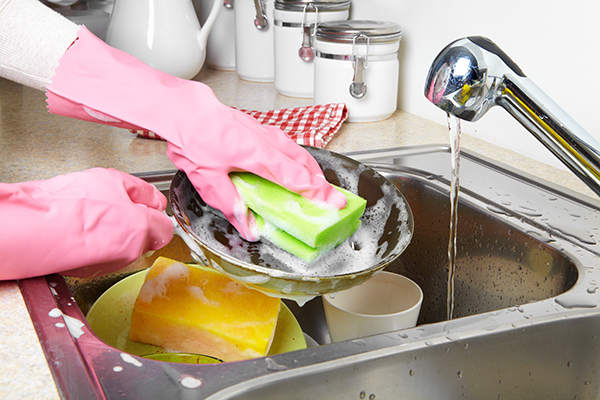Safe Food for Our Senior Customers
 The consumer’s ultimate expectation is quality food and additionally, not to get sick from the food they eat at a restaurant or food service commissary. In the case of our senior citizens, they are in a special class, referred to in food safety circles as a high-risk group or highly susceptible population. Other high-risk patrons are small children, pregnant mothers and babies, people taking certain medications, and people that are otherwise immune-compromised. What puts seniors in that special class is their bodies have a lessened ability to fight off dangerous pathogens that might invade through contaminated food.
The consumer’s ultimate expectation is quality food and additionally, not to get sick from the food they eat at a restaurant or food service commissary. In the case of our senior citizens, they are in a special class, referred to in food safety circles as a high-risk group or highly susceptible population. Other high-risk patrons are small children, pregnant mothers and babies, people taking certain medications, and people that are otherwise immune-compromised. What puts seniors in that special class is their bodies have a lessened ability to fight off dangerous pathogens that might invade through contaminated food.
Our best elder consumers – Senior citizens have had a lifetime of experience shopping, preparing, and eating food. Federal studies show that seniors do a better job of actually handling food safely than any other age group, so food service facilities need to take heed. Statistics also show that nearly 50% of the money Americans spend on food goes to buy food that others prepare, like “carry out” and restaurant meals. Healthcare facilities such as nursing homes, assisted living, and acute care facilities are responsible for almost 100% of the food that is eaten by patients or clients in their captive audience.
Why are seniors more susceptible to foodborne illness? Everyone’s health is different, including his or her ability to fight off disease. Immune systems weaken as we age. Stomach acid also decreases as we get older—and stomach acid plays an important role in reducing the number of bacteria in our intestinal tracts—and the risk of illness. Plus, for senior citizens, underlying illnesses such as diabetes, some cancer treatments, and kidney disease may increase a person’s risk of foodborne illness. So, aside from being a bit more demanding customers for restaurants, seniors are special customers when it comes to safe food.
Consumer Advisory – In the FDA Food Code (Chapter 3-603.11 / 2013 FDA Food Code), restaurants must follow the recommendation to notify their customers if they choose to consume raw or undercooked meats, poultry, seafood, shellfish, or eggs, as it may increase their risk of foodborne illness. This type of written statement is called the “consumer advisory.” It must be posted using brochures, signs on deli cases, package labels, menu statements, table tents, or other effective written means for consumers to read. So seniors beware when you see such a warning.
Foods Seniors Are Advised Not To Eat –To reduce risks of illness from bacteria or other pathogens, seniors and other high risk groups are advised NOT to eat:
• Raw fin fish and shellfish, including oysters, clams, mussels, and scallops. This includes some types of sushi.
• Hot dogs and luncheon meats, unless they are reheated until steaming hot.
• Raw or unpasteurized milk or soft cheeses (such as Feta, Brie, Camembert, blue-veined, and Mexican-style cheese) unless they are labeled “made with pasteurized milk.” Hard cheeses, processed cheeses, cream cheese, cottage cheese, or yogurt need not be avoided.
• Refrigerated pâtés or meat spreads. Canned or shelf-stable meat spreads may be eaten.
• Refrigerated smoked seafood unless it is contained in a cooked dish, such as a casserole. Examples of these raw or undercooked foods are smoked versions of salmon, trout, whitefish, cod, tuna, or mackerel, that are most often labeled as “nova style,” “kippered,” or “lox” and are found in grocery type delis.
• Canned smoked seafood may be eaten safely.
• Raw or lightly cooked eggs (such as over easy or sunny-side up). Products containing raw eggs such as salad dressings, cookie or cake batter, homemade ice cream, sauces, and beverages such as eggnog. Such foods made from commercially pasteurized eggs are safe.
• Raw meat or poultry. Rare ground meats of any kind.
• Raw sprouts (alfalfa, clover, and radish).Unpasteurized or untreated fresh fruit or vegetable juice (they will carry a warning label). When fruits and vegetables are made into fresh-squeezed juice, harmful bacteria that may be present can become part of the finished product. 98% of the juice in the United States is pasteurized or otherwise treated to kill harmful bacteria.
Bottom Line: Seniors are an important part of our customer base in food service so cater to them and keep your foods safe. As for the doggie bag, because portions are larger than ever from restaurants and seniors don’t consume big meals, restaurants and commissaries should be careful to provide warning labels asking to refrigerate foods immediately to keep them safe on carry-out foods. If that senior consumer will not arrive home within 2 hours of finishing the meal, it is safer to leave the leftovers at the restaurant. Some senior centers have policies that do not allow leftovers to be taken home because of that risk.
***
About the Author: Lacie Thrall

This information is provided as a general guideline and is not intended to be, nor does it, constitute legal or regulatory advice. Additional Federal regulations may apply to your particular circumstances. State, regional and local laws, ordinances and regulations may also apply.
READ MORE POSTS
Properly Cleaning and Sanitizing: The Right Chemical Mix to Maintain Ultimate Effectiveness
A few weeks ago, my family and I had the pleasure of setting sail on a cruise vacation. It is truly one of the only ways that I find that I am able to unplug from work and relax for a small spell. However, as I walked around the ship in our post-COVID world, I couldn’t help but admire all the extra cleaning steps the staff were undertaking to keep us all as safe as possible while in the middle of the ocean with 3,000 other vacationers. All of this cleaning and sanitizing had me thinking about how we each clean and sanitize our own operations and which chemicals we chose to use.
Proper Cooking Temperature: A Basic Food Safety Measure
Each summer, we see an increase in the incidence of foodborne illnesses. Perhaps this is because of the warmer temperatures making temperature control for Time/Temperature Control for Safety (TCS) food more difficult or perhaps it is the increased amount of people who are barbequing this time of year – it is National Picnic Month, after all!
Changing Climate: The Unseen Impact on Food Safety
In June, I was asked to participate in the Allinfoodz podcast, put on by a colleague, Dr. Amit Sharma, at Penn State University. One of the points Dr. Sharma wanted to discuss was the impact of climate change on food safety, which is something I was certainly aware of, but not something I had done much research on. However, when preparing for the interview and podcast, it was interesting to learn more about the relationship between the two.
Thawing Food with Food Safety in Mind
There comes a time in almost every foodservice operation where you must thaw food. Yes, I know there are those operations who have moved to fresh products only and don’t have a freezer in-house, but I am willing to bet that is more the exception than the norm. I am almost sure that anyone reading this blog who works in a foodservice operation can regurgitate what methods are acceptable to thaw food per the FDA Model Food Code. In case you don’t recall, I will discuss them briefly, but I wanted to spend some time covering these requirements a bit more in-depth – so you not only know WHAT to do, but the WHY we do it that way.










